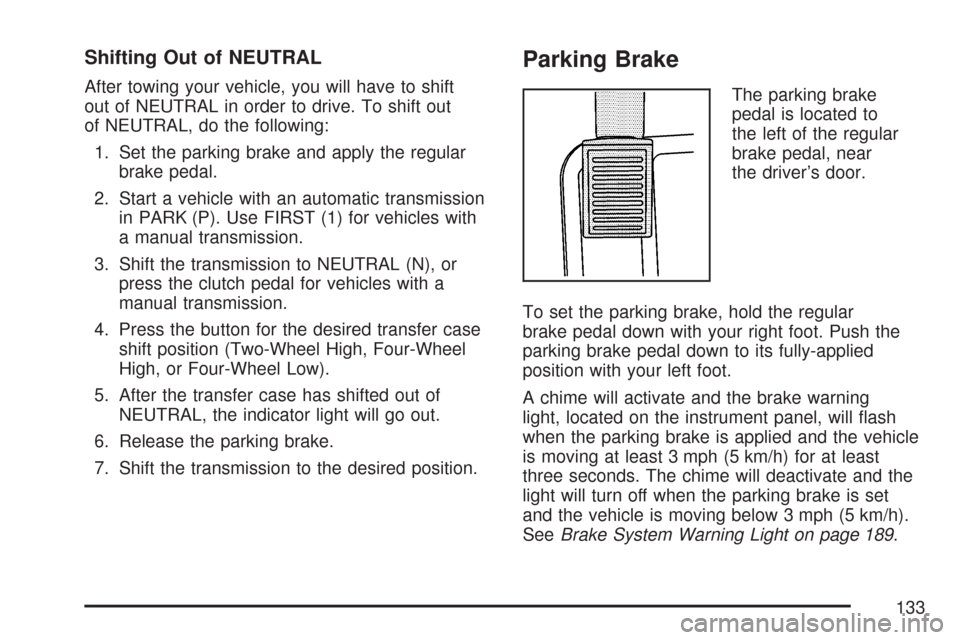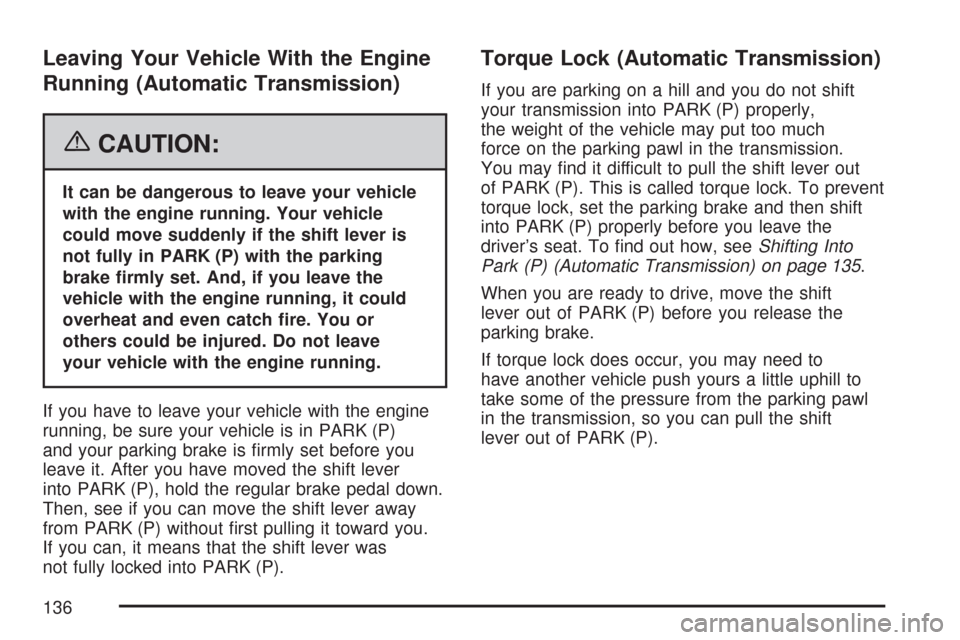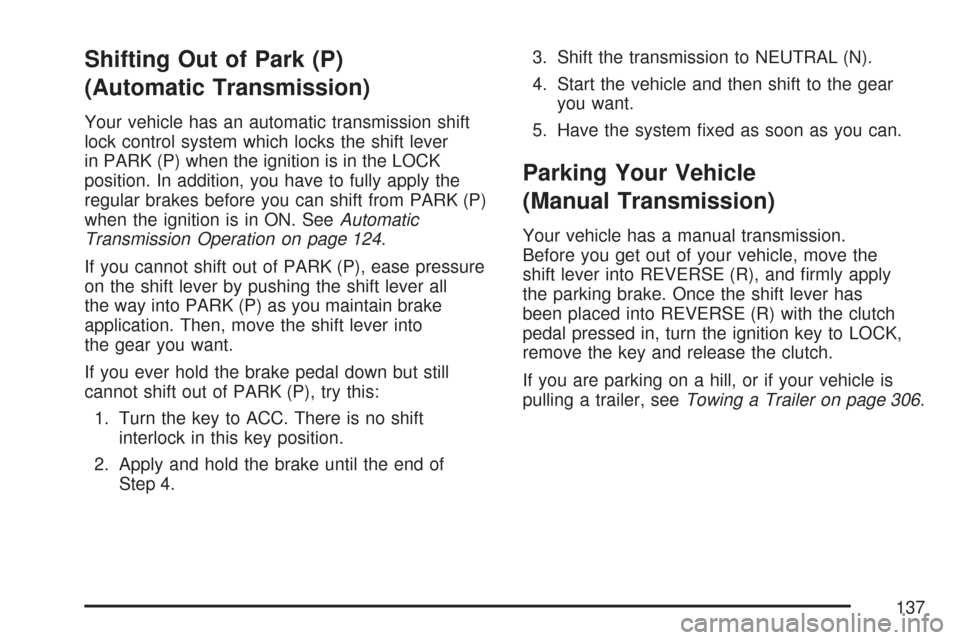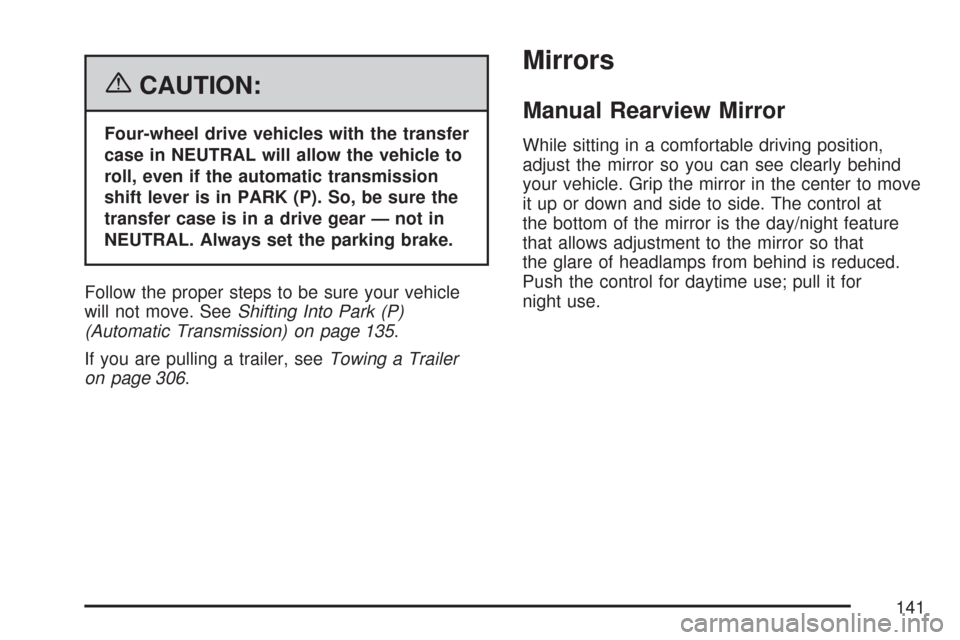2007 CHEVROLET COLORADO automatic transmission
[x] Cancel search: automatic transmissionPage 131 of 496

Shifting from Four-Wheel High to
Two-Wheel High
Press and release the Two-Wheel High button.
This can be done at any speed, and the front
axle will unlock automatically.
It is normal to hear and feel your vehicle’s transfer
case shift into Four-Wheel High. If you shift with
the vehicle stopped, the indicator light may
still �ash slowly. It may be necessary to shift the
transmission momentarily into REVERSE (R)
and DRIVE (D), for an automatic transmission,
or REVERSE (R) and FIRST (1) for a manual
transmission to have the light stop �ashing.
Shifting from Two-Wheel High or
Four-Wheel High to Four-Wheel Low
To shift from Two-Wheel High or Four-Wheel High
to Four-Wheel Low, the vehicle must be stopped
or moving less than 3 mph (5 km/h) with the
transmission in NEUTRAL (N) for an automatic
transmission or the clutch pedal pressed for
a manual transmission. The preferred method for
shifting into Four-Wheel Low is to have your
vehicle moving 1 to 2 mph (1.6 to 3.2 km/h).Press and release the Four-Wheel Low button.
You must wait for the Four-Wheel Low indicator
light to stop �ashing and stay on before shifting
the transmission into gear or releasing the
clutch pedal.
If the Four-Wheel Low button is pressed when
your vehicle is in gear and/or moving faster
than 3 mph (5 km/h), the four-wheel low indicator
light will �ash for 30 seconds and not complete
the shift.
Shifting from Four-Wheel Low to
Two-Wheel High or Four-Wheel High
To shift from Four-Wheel Low to Two-Wheel
High or Four-Wheel High, your vehicle must be
stopped or moving less than 3 mph (5 km/h)
with the transmission in NEUTRAL (N) for
an automatic transmission or the clutch pedal
pressed for a manual transmission. The preferred
method for shifting out of four-wheel low is
to have your vehicle moving 1 to 2 mph
(1.6 to 3.2 km/h).
131
Page 133 of 496

Shifting Out of NEUTRAL
After towing your vehicle, you will have to shift
out of NEUTRAL in order to drive. To shift out
of NEUTRAL, do the following:
1. Set the parking brake and apply the regular
brake pedal.
2. Start a vehicle with an automatic transmission
in PARK (P). Use FIRST (1) for vehicles with
a manual transmission.
3. Shift the transmission to NEUTRAL (N), or
press the clutch pedal for vehicles with a
manual transmission.
4. Press the button for the desired transfer case
shift position (Two-Wheel High, Four-Wheel
High, or Four-Wheel Low).
5. After the transfer case has shifted out of
NEUTRAL, the indicator light will go out.
6. Release the parking brake.
7. Shift the transmission to the desired position.
Parking Brake
The parking brake
pedal is located to
the left of the regular
brake pedal, near
the driver’s door.
To set the parking brake, hold the regular
brake pedal down with your right foot. Push the
parking brake pedal down to its fully-applied
position with your left foot.
A chime will activate and the brake warning
light, located on the instrument panel, will �ash
when the parking brake is applied and the vehicle
is moving at least 3 mph (5 km/h) for at least
three seconds. The chime will deactivate and the
light will turn off when the parking brake is set
and the vehicle is moving below 3 mph (5 km/h).
SeeBrake System Warning Light on page 189.
133
Page 135 of 496

Shifting Into Park (P)
(Automatic Transmission)
{CAUTION:
It can be dangerous to get out of your
vehicle if the shift lever is not fully in
PARK (P) with the parking brake �rmly
set. Your vehicle can roll. If you have
left the engine running, the vehicle can
move suddenly. You or others could
be injured. To be sure your vehicle will
not move, even when you are on fairly
level ground, use the steps that follow.
If you are pulling a trailer, seeTowing
a Trailer on page 306.
1. Hold the brake pedal down with your right
foot and set the parking brake.
SeeParking Brake on page 133for more
information.
{CAUTION:
If you have four-wheel drive, your vehicle
will be free to roll — even if your shift
lever is in PARK (P) — if your transfer
case is in NEUTRAL. So, be sure the
transfer case is in a drive gear, two-wheel
high (2H) or four-wheel high (4H) or
four-wheel low (4L) — not in NEUTRAL.
2. Move the shift lever into PARK (P) by
pulling the lever toward you and moving
it up as far as it will go.
3. Turn the ignition key to LOCK.
4. Remove the key and take it with you.
If you can leave your vehicle with the
key, your vehicle is in PARK (P).
135
Page 136 of 496

Leaving Your Vehicle With the Engine
Running (Automatic Transmission)
{CAUTION:
It can be dangerous to leave your vehicle
with the engine running. Your vehicle
could move suddenly if the shift lever is
not fully in PARK (P) with the parking
brake �rmly set. And, if you leave the
vehicle with the engine running, it could
overheat and even catch �re. You or
others could be injured. Do not leave
your vehicle with the engine running.
If you have to leave your vehicle with the engine
running, be sure your vehicle is in PARK (P)
and your parking brake is �rmly set before you
leave it. After you have moved the shift lever
into PARK (P), hold the regular brake pedal down.
Then, see if you can move the shift lever away
from PARK (P) without �rst pulling it toward you.
If you can, it means that the shift lever was
not fully locked into PARK (P).
Torque Lock (Automatic Transmission)
If you are parking on a hill and you do not shift
your transmission into PARK (P) properly,
the weight of the vehicle may put too much
force on the parking pawl in the transmission.
You may �nd it difficult to pull the shift lever out
of PARK (P). This is called torque lock. To prevent
torque lock, set the parking brake and then shift
into PARK (P) properly before you leave the
driver’s seat. To �nd out how, seeShifting Into
Park (P) (Automatic Transmission) on page 135.
When you are ready to drive, move the shift
lever out of PARK (P) before you release the
parking brake.
If torque lock does occur, you may need to
have another vehicle push yours a little uphill to
take some of the pressure from the parking pawl
in the transmission, so you can pull the shift
lever out of PARK (P).
136
Page 137 of 496

Shifting Out of Park (P)
(Automatic Transmission)
Your vehicle has an automatic transmission shift
lock control system which locks the shift lever
in PARK (P) when the ignition is in the LOCK
position. In addition, you have to fully apply the
regular brakes before you can shift from PARK (P)
when the ignition is in ON. SeeAutomatic
Transmission Operation on page 124.
If you cannot shift out of PARK (P), ease pressure
on the shift lever by pushing the shift lever all
the way into PARK (P) as you maintain brake
application. Then, move the shift lever into
the gear you want.
If you ever hold the brake pedal down but still
cannot shift out of PARK (P), try this:
1. Turn the key to ACC. There is no shift
interlock in this key position.
2. Apply and hold the brake until the end of
Step 4.3. Shift the transmission to NEUTRAL (N).
4. Start the vehicle and then shift to the gear
you want.
5. Have the system �xed as soon as you can.
Parking Your Vehicle
(Manual Transmission)
Your vehicle has a manual transmission.
Before you get out of your vehicle, move the
shift lever into REVERSE (R), and �rmly apply
the parking brake. Once the shift lever has
been placed into REVERSE (R) with the clutch
pedal pressed in, turn the ignition key to LOCK,
remove the key and release the clutch.
If you are parking on a hill, or if your vehicle is
pulling a trailer, seeTowing a Trailer on page 306.
137
Page 140 of 496

Running the Engine While Parked
It is better not to park with the engine running. But if
you ever have to, here are some things to know.
{CAUTION:
Idling the engine with the climate control
system off could allow dangerous exhaust
into your vehicle. See the earlier caution
underEngine Exhaust on page 139.
Also, idling in a closed-in place can let
deadly carbon monoxide (CO) into your
vehicle even if the climate control fan is
at the highest setting. One place this
can happen is a garage. Exhaust — with
CO — can come in easily. NEVER park
in a garage with the engine running.
Another closed-in place can be a blizzard.
SeeWinter Driving on page 286.
{CAUTION:
It can be dangerous to get out of your
vehicle if the automatic transmission shift
lever is not fully in PARK (P) with the
parking brake �rmly set. Your vehicle can
roll. Do not leave your vehicle when the
engine is running unless you have to.
If you have left the engine running, the
vehicle can move suddenly. You or others
could be injured. To be sure your vehicle
will not move, even when it is on fairly
level ground, always set the parking brake
and move the automatic transmission
shift lever to PARK (P), or the manual
transmission shift lever to NEUTRAL.
140
Page 141 of 496

{CAUTION:
Four-wheel drive vehicles with the transfer
case in NEUTRAL will allow the vehicle to
roll, even if the automatic transmission
shift lever is in PARK (P). So, be sure the
transfer case is in a drive gear — not in
NEUTRAL. Always set the parking brake.
Follow the proper steps to be sure your vehicle
will not move. SeeShifting Into Park (P)
(Automatic Transmission) on page 135.
If you are pulling a trailer, seeTowing a Trailer
on page 306.
Mirrors
Manual Rearview Mirror
While sitting in a comfortable driving position,
adjust the mirror so you can see clearly behind
your vehicle. Grip the mirror in the center to move
it up or down and side to side. The control at
the bottom of the mirror is the day/night feature
that allows adjustment to the mirror so that
the glare of headlamps from behind is reduced.
Push the control for daytime use; pull it for
night use.
141
Page 157 of 496

Instrument Panel Overview........................ 160
Hazard Warning Flashers.......................... 162
Other Warning Devices............................. 162
Horn.......................................................... 162
Tilt Wheel.................................................. 162
Turn Signal/Multifunction Lever.................. 163
Turn and Lane-Change Signals................. 164
Headlamp High/Low-Beam Changer.......... 165
Flash-to-Pass............................................ 165
Windshield Wipers..................................... 165
Windshield Washer.................................... 166
Cruise Control........................................... 166
Exterior Lamps.......................................... 170
Headlamps on Reminder........................... 171
Daytime Running Lamps (DRL)................. 171
Automatic Headlamp System..................... 172
Fog Lamps................................................ 173
Exterior Cargo Lamps................................ 174
Interior Lamps........................................... 174
Instrument Panel Brightness...................... 174
Dome Lamp.............................................. 174Dome Lamp Override................................ 175
Exit Lighting.............................................. 175
Electric Power Management...................... 175
Battery Run-Down Protection..................... 175
Accessory Power Outlet(s)........................ 176
Ashtray(s) and Cigarette Lighter................ 177
Climate Controls......................................... 177
Climate Control System............................. 177
Outlet Adjustment...................................... 180
Warning Lights, Gages, and Indicators..... 181
Instrument Panel Cluster........................... 182
Speedometer and Odometer...................... 183
Trip Odometer........................................... 183
Tachometer............................................... 183
Safety Belt Reminder Light........................ 184
Passenger Safety Belt Reminder Light....... 184
Airbag Readiness Light............................. 185
Passenger Airbag Status Indicator............. 186
Battery Warning Light................................ 188
Up-Shift Light (Manual Transmission)........ 189
Section 3 Instrument Panel
157